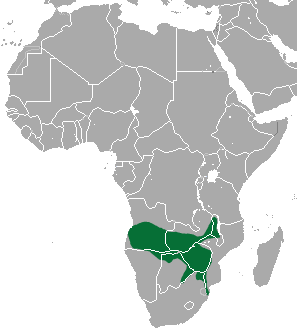Selous's mongoose facts for kids
Quick facts for kids Selous's mongoose |
|
|---|---|
 |
|
| Conservation status | |
| Scientific classification | |
| Genus: |
Paracynictis
|
| Species: |
selousi
|
 |
|
| Selous' mongoose range | |
The Selous's mongoose (Paracynictis selousi) is a cool animal that lives in Southern Africa. It's a type of mongoose, and it's the only species in its group, called Paracynictis.
Contents
Where Does the Selous's Mongoose Live?
This mongoose lives only in Southern Africa. You can find it in countries like Angola, Zambia, Malawi, Namibia, Botswana, Zimbabwe, Mozambique, and South Africa. It prefers open areas with bushes and trees, but it doesn't live in thick forests or very dry deserts.
What Does a Selous's Mongoose Look Like?
The Selous's mongoose is about 63 to 90 centimeters (25 to 35 inches) long, including its tail. Its tail alone is 28 to 43 centimeters (11 to 17 inches) long! It weighs around 1.4 to 2.0 kilograms (3 to 4.4 pounds).
Its fur can be light gray with speckles or a brownish-gray color. Its belly is usually lighter. Its legs are brown or black. A special feature is its tail, which has a white tip. This helps tell it apart from other mongooses. The Selous's mongoose is also smaller and thinner than the white-tailed mongoose.
This animal has four toes on each foot. Its claws are long and a little curved, which are perfect for digging. Female Selous's mongooses have three pairs of nipples on their belly, while males do not.
How Does the Selous's Mongoose Behave?
The Selous's mongoose is mostly active at night. This means it's a nocturnal animal. However, sometimes you might see one out during the day.
Even though they usually live alone, sometimes you might spot a pair of mongooses together. It's also common to see a mother mongoose with her young ones.
These mongooses are great at digging their own homes, called burrows. But if they find an empty burrow made by another animal, they might use that too!
Self-Defense and Food
The Selous's mongoose has a special way to protect itself. It can release a strong-smelling liquid from a gland near its tail. This bad smell helps scare away enemies. The white tip on its tail might even be a warning sign to others about this ability.
What do they eat? Their favorite food is invertebrates, which are creatures without backbones, like insects. They also enjoy eating small rodents, amphibians (like frogs), reptiles (like lizards), and birds. Their front claws are super useful for digging up beetle larvae and other food hidden underground or in leaf piles.
Life Cycle and Young
Female Selous's mongooses usually give birth to two to four babies at a time. The young are typically born between August and March.
Conservation Status
Good news! The Selous's mongoose is considered a species of "least concern" by conservation groups. This means there are lots of them, and they are not currently in danger. There are no big threats known to this species, and they live across a wide area.
What's in a Name?
This mongoose is named after a famous explorer and hunter, Frederick Selous. Both "Selous's mongoose" and "Selous’ mongoose" are correct ways to spell its name.
People in Africa have other names for this mongoose in their own languages:
- Afrikaans: Kleinwitstertmuishond
- Zulu: Nsengane
- Tswana: Kgano
- Shona: Jerenyenje


